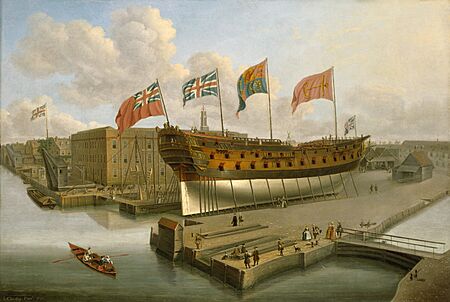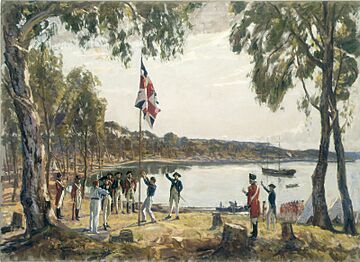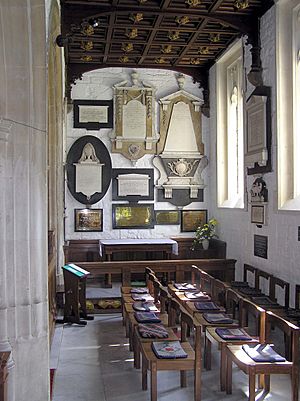Arthur Phillip facts for kids
Quick facts for kids
Admiral
Arthur Phillip
|
|
|---|---|
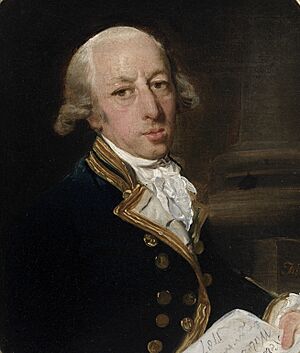
Captain Arthur Phillip, 1786, by Francis Wheatley
|
|
| 1st Governor of New South Wales | |
| In office 7 February 1788 – 10 December 1792 |
|
| Monarch | George III |
| Preceded by | Position established |
| Succeeded by | John Hunter |
| Personal details | |
| Born | 11 October 1738 Cheapside, London, England |
| Died | 31 August 1814 (aged 75) Bath, Somerset, England |
| Military service | |
| Allegiance | |
| Branch/service | |
| Rank | Admiral of the Blue |
| Battles/wars |
|
Arthur Phillip (11 October 1738 – 31 August 1814) was a British Royal Navy officer and the first Governor of New South Wales. He is famous for leading the First Fleet, a group of 11 ships that sailed from England to Australia in 1787. He established a new settlement that grew into the city of Sydney. As governor, Phillip faced many challenges, but he worked hard to help the new colony survive and grow.
Contents
A Sailor's Beginnings
Arthur Phillip was born in London, England, on October 11, 1738. His father was a language teacher from Germany, and his mother was English. After his father died, his family did not have much money.
At age 13, Phillip went to a special school for the sons of sailors called the Greenwich Hospital School. There, he learned reading, math, and skills for navigating ships. At 15, he began working as an apprentice on a whaling ship called Fortune.
Phillip's life at sea was full of adventure. He joined the Royal Navy in 1755 during the Seven Years' War against France. He served on several ships and took part in battles, including the Battle of Minorca and the Siege of Havana. He was a skilled and brave officer, and he was promoted to lieutenant in 1761.
For a time, Phillip also served as a captain in the Portuguese Navy, helping Portugal in a war against Spain. He returned to the Royal Navy in 1778 and was given command of his own ships. His experience sailing around the world and leading crews made him a respected commander.
A New Colony in Australia
After the American Revolutionary War, Britain could no longer send people who had broken the law, known as convicts, to its colonies in America. The British government needed a new place to send them. Sir Joseph Banks, a scientist who had sailed with Captain James Cook, suggested Botany Bay in Australia.
In 1786, the government decided to start a new penal colony there. They chose Arthur Phillip to lead the expedition. He was appointed commander of the fleet and the future governor of the new colony, which was named New South Wales.
The Voyage of the First Fleet
The group of ships Phillip commanded was called the First Fleet. It was made up of 11 ships carrying over 1,400 people, including sailors, marines (soldiers), and about 780 convicts.
The fleet set sail from Portsmouth, England, on May 13, 1787. The journey was very long, taking eight months to cross the ocean. They stopped for supplies in Tenerife, Rio de Janeiro, and Cape Town before making the final long trip to Australia. The first ships arrived at Botany Bay on January 18, 1788.
Founding Sydney
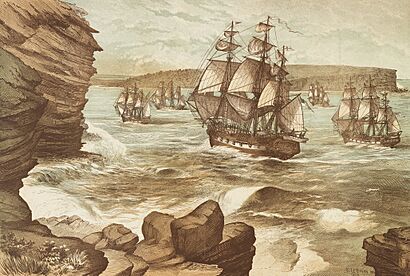
Phillip quickly realized that Botany Bay was not a good place for a settlement. The soil was poor for farming, and there was not enough fresh water or a safe place for the ships to anchor.
He explored the coast nearby and found a much better location. It was a large, natural harbor that he called Port Jackson. On January 26, 1788, the fleet moved to a small bay within the harbor which Phillip named Sydney Cove, in honor of Lord Sydney, the British official in charge of the plan. This is where the city of Sydney began. The date is now celebrated as Australia Day.
Governor of New South Wales
As governor, Phillip's job was to build a successful colony from scratch. This was very difficult. The new arrivals had to build houses, plant crops, and find food.
Early Challenges
Phillip had asked for skilled workers like farmers and carpenters, but very few were sent. The soil around Sydney Cove was not good for farming, and the settlers struggled to grow enough food. Supplies were often very low, and everyone, including Phillip himself, had to live on small rations.
He also had to keep order, not just among the convicts but also with the marines (soldiers) who were there to guard the settlement. Phillip set up a system of laws and courts to make sure everyone was treated fairly. He believed in discipline but was often merciful, reducing harsh punishments when he could.
Relations with Aboriginal People
Phillip was instructed to have a friendly relationship with the native people of the land, the Aboriginal people. The local people were from the Eora nation. At first, they were curious about the newcomers, and gifts were exchanged.
However, cultural differences and misunderstandings soon led to conflict. Phillip tried to learn more about the Eora by inviting some of them to the settlement. He formed a connection with a man named Bennelong, who taught him about the local language and customs.
Despite Phillip's efforts for peace, there were clashes between the settlers and the Aboriginal people as the colony expanded. When some colonists were attacked, Phillip sent soldiers to respond, hoping to prevent more fighting. The relationship remained complicated throughout his time as governor.
Return to England and Later Life
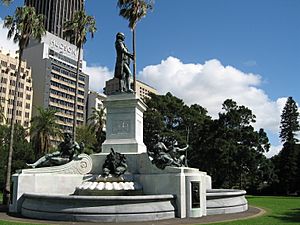
By 1792, Phillip's health was poor, and he decided to return to England. He sailed from Sydney in December 1792, taking Bennelong and another Aboriginal man named Yemmerrawanne with him. He had hoped to return to Australia, but his doctors advised him to resign as governor.
Back in England, his health improved. He returned to the Royal Navy and served in several commands during the wars against France. He retired in 1805 and was promoted to the rank of Admiral.
Arthur Phillip died on August 31, 1814, in the city of Bath. He was buried in a nearby church. For many years, his grave was forgotten, but it was rediscovered in 1897.
Phillip's Legacy
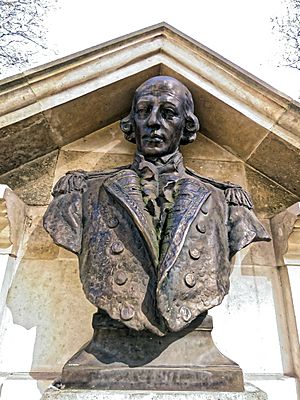
Arthur Phillip is remembered as the founder of the first European settlement in Australia. Despite the incredible hardships, his leadership helped the colony of New South Wales survive its difficult early years.
Many places in Australia are named after him, including Port Phillip Bay and Phillip Island in Victoria, and Phillip Street in Sydney. There are statues and memorials honoring him in both Australia and England. He is seen as a key figure in the history of modern Australia.
See also
 In Spanish: Arthur Phillip para niños
In Spanish: Arthur Phillip para niños


